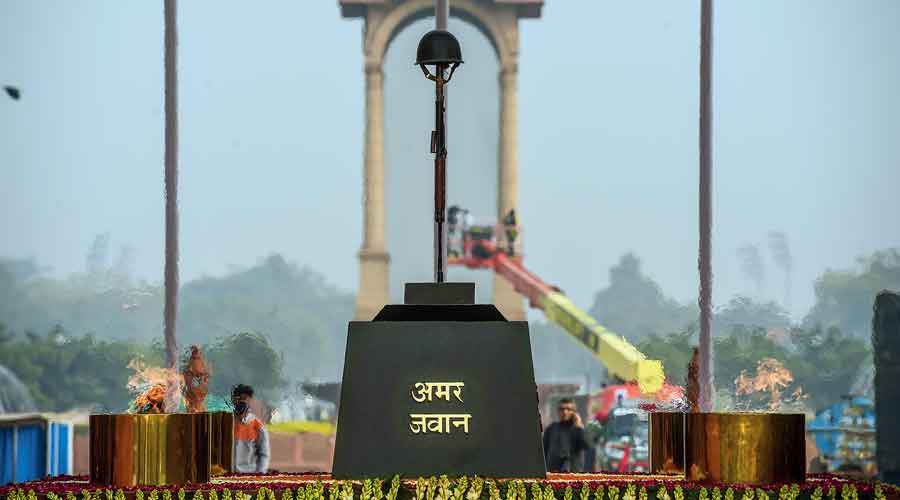The Amar Jawan Jyoti, the eternal flame in memory of soldiers killed in action, was put out on Friday five days short of its 50th anniversary, after it was “merged” with the one at the National War Memorial, unveiled less than three years ago.
The Amar Jawan Jyoti was first lit on Republic Day of 1972 in memory of soldiers killed in the Bangladesh Liberation War in December 1971, although it mentions no names.
It was placed under the arch of the India Gate, built by the British in 1931 in memory of 90,000 soldiers killed in wars such as the First World War and the Third Anglo-Afghan War. It has the names of fallen soldiers inscribed on it.
The Amar Jawan Jyoti has four urns, in one of which the eternal flame burnt constantly. On important days like Republic Day and Independence Day, all four urns would be lit.
The four urns are on a marble pedestal with a cenotaph. The words “Amar Jawan” (immortal soldier) are written in gold on all four sides of the cenotaph, which acts as the plinth for a rifle on its barrel capped by the helmet of the “unknown soldier”.
According to officers privy to discussions back in the early 1970s, the Amar Jawan Jyoti was to be a temporary fixture till the time a National War Memorial was built to honour all those killed in action since Independence. This was a task undertaken by the Modi government in 2015.
The National War Memorial opened close to India Gate in February 2019 but at that time the plan was to keep the Amar Jawan Jyoti as it is.
The Amar Jawan Jyoti continued to attract people despite much of the area having been dug up and subject to restrictions — owing to the pandemic, Republic Day Parade rehearsals and the construction of the Central Vista.
It appeared that the National War Memorial — while getting considerable footfall — did not get the kind of attention India Gate and the Amar Jawan Jyoti still drew.
Opinion over Friday’s movewithin the services appeared divided. And even among the many who agreed with the government’s decision, there was clarity that there should be no effort to belittle the sacrifices made by soldiers who were killed in action pre-Independence.
A retired general and veteran of the 1971 war who did not want to be quoted underlined that many army units traced their history to pre-Independence times.
He said both flames could have co-existed. He said the government was right when it said the Amar Jawan Jyoti was a temporary fixture, but rejected the bid to create a difference between soldiers killed before and after Independence. “They were all soldiers of a professional army and should find mention in the National War Memorial. Or make India Gate — where the names of those killed in action before 1947 are etched — a part of the complex,” he said.
A former chief of integrated defence staff, Lt Gen. (retd) Satish Dua, tweeted: “It gives me great satisfaction that the eternal flame of Amar Jawan Jyoti at India Gate is being merged with the National War Memorial (NWM)….”
The former army chief, Gen. Ved Malik, tweeted: “A natural thing to do now that the National War Memorial has been established….”
Maj. Gen. (retd) Yash Mor told The Telegraph that the National War Memorial had been welcomed by the armed forces and the logistics of keeping two flames alight in perpetuity was not practical. But, he said: “I feel the relevance of India Gate cannot be reduced. In fact, the fading names must be re-etched.”
However, former Air Vice-Marshal Manmohan Bahadur urged the Prime Minister to reconsider the decision to extinguish the Amar Jawan Jyoti flame, saying it was part of India’s “psyche”. He tweeted: “Symbols hav(e) an intangible VALUE in nation building — the ‘Eternal Flame’ at India Gate is/ was iconic…. WE ALL will lose a part of OUR lives.”










